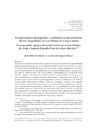Identificador persistente para citar o vincular este elemento:
https://accedacris.ulpgc.es/handle/10553/55788
| Título: | Envejecimiento demográfico y exclusión social en barrios obreros degradados de Las Palmas de Gran Canaria | Otros títulos: | Demographic aging and social exclusion in Las Palmas de Gran Canaria degraded worker-class districts | Autores/as: | Boldú Hernández, Jordi Domínguez Mujica, Josefina |
Clasificación UNESCO: | 520306 Demografía urbana 520303 Demografía local |
Palabras clave: | Urban Vulnerability Environmental Gerontology Life Cycle Demographic Aging Lower-Class District, et al. |
Fecha de publicación: | 2018 | Publicación seriada: | Estudios Geográficos | Resumen: | The aim of this article is the characterization of the urban vulnerability of two worker-class districts in Las Palmas de Gran Canaria: San Nicolas y La Isleta. The lifecycle of these districts and of their neighbors parallel run, so the aging of their population and of housing fabric is shown as an obvious sign of obsolescence and urban and demographic atony in the main city of Gran Canaria (Spain). To determine the current level of their vulnerability quantitative and qualitative methods are used in this research. The first of them allow the sociodemographic study (Census of Population and Continuous Census) and of the housing and urban fabric (Census of Housing and Cadaster); the second (interviews and discussion groups) offer the statements of their neighbors with regard to their feelings of belonging to those districts. The results of the research developed exhibit the interest of environmental gerontology at a microscale level, to diagnose situations that require differentiated treatment in urban areas, contributing to palliate the vulnerability and to construct fairer cities from a social and spatial point of view. El objeto de estudio de este artículo lo constituye la caracterización de la vulnerabilidad urbana de dos barrios obreros de Las Palmas de Gran Canaria: San Nicolás y La Isleta. El ciclo de vida de dichos barrios y el de sus vecinos corren paralelamente, de forma que el envejecimiento de sus poblaciones y de su tejido habitacional se muestra como un signo de obsolescencia y de atonía urbana y demográfica en la capital de Gran Canaria (España). Para definir el estado actual de vulnerabilidad que los afecta, en esta investigación se utilizan técnicas cuantitativas y cualitativas de análisis. Las primeras permiten el estudio sociodemográfico (Censo de Población y del Padrón) y de su tejido habitacional y urbano (Censo de Viviendas y Catastro); las segundas (entrevistas y grupos de discusión) ofrecen el testimonio de sus residentes en relación con su sentimiento de pertenencia a dichos barrios. Los resultados de la investigación desarrollada muestran el interés de la gerontología ambiental, a nivel de microescala, para diagnosticar situaciones que requieren un tratamiento diferenciado en ámbitos urbanos, con la intención de paliar la vulnerabilidad y contribuir a la construcción de ciudades más justas desde un punto de vista social y espacial |
URI: | https://accedacris.ulpgc.es/handle/10553/55788 | ISSN: | 0014-1496 | DOI: | 10.3989/estgeogr.201818 | Fuente: | Estudios Geograficos [ISSN 0014-1496],v. 79 (285), p. 469-500, (Julio-Diciembre 2018) |
| Colección: | Artículos |
Citas SCOPUSTM
2
actualizado el 08-jun-2025
Visitas
370
actualizado el 30-nov-2024
Descargas
443
actualizado el 30-nov-2024
Google ScholarTM
Verifica
Altmetric
Comparte
Exporta metadatos
Los elementos en ULPGC accedaCRIS están protegidos por derechos de autor con todos los derechos reservados, a menos que se indique lo contrario.
